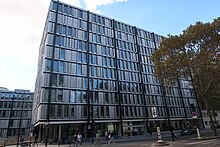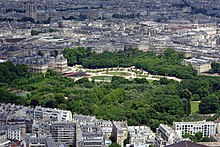6th arrondissement (Paris)
|
6th Arrondissement (Luxembourg) Arrondissement municipal of Paris |
|
|---|---|
| Coordinates | 48 ° 50 '58 " N , 2 ° 19' 47" E |
| height | 39 m (29– 57 m ) |
| surface | 2.15 km² |
| Residents | 41,100 (Jan. 1, 2017) |
| Population density | 19,116 inhabitants / km² |
| INSEE code | 75106 |
| Post Code | 75006 |
| Website | mairie6.paris.fr |
| structure | |
| Quarters |
|
The 6th arrondissement of Paris , the Arrondissement du Luxembourg , has its origins in the Roman settlement of the left bank of the Seine ( Rive Gauche ). However, the concentrated expansion to the south did not take place until the 19th century . The lifeline of the “Sixth” is the Boulevard Saint-Germain , which, like the entire district, bears its name after the Saint-Germain-des-Prés church . The 6th arrondissement can be read as a kind of continuation of the Latin Quarter . The district stretches from the Seine to the busy Boulevard du Montparnasse and is considered to be the capital's most important science and cultural district.
The Quartier Saint-Germain-des-Prés is the legendary art and literary district that reached its peak in the 1920s and was the focus of socio-political events in May 1968 . With its small streets and squares, most of which still correspond to the layout of the city before the reforms of the urban planner Georges-Eugène Haussmann in the 19th century, the quarter is now home to a large number of bookshops, stylish cafés, restaurants, second-hand bookshops, galleries and fashion boutiques. Due to its illustrious residents (including Jean-Paul Sartre , Simone de Beauvoir , Pablo Picasso and Gertrude Stein ), the proximity to the university quarter and the quiet streets, the quarter has always been associated with the educated French class.
The French Senate meets today in the Palais du Luxembourg , which was built around 1620 for Marie de Medici , the widow of Henri IV . The Jardin du Luxembourg , which is a famous example of the classical landscape architecture in France, is also a popular meeting place among students and marks the dividing line to the 5th arrondissement .
Geographical location
The 6th arrondissement is located directly on the Rive Gauche , the left bank of the Seine . It borders the 5th arrondissement in the east, the 14th arrondissement in the south and the 15th and 7th arrondissement in the west . On the opposite side of the Seine is the 1st arrondissement , with the western tip of the Île de la Cité .
Quarter in the 6th arrondissement
The 6th arrondissement consists of the following four districts:
- Quartier de la Monnaie
- Quartier de l'Odéon
- Notre-Dame-des-Champs district
- Saint-Germain-des-Prés district
According to the official census of the Parisian districts, these are Quartiers 21 to 24.
Demographic data
According to the 1999 census , 44,903 inhabitants are registered in the 215 hectare arrondissement. This corresponds to a population density of 20,893 inhabitants / km².
Politics and administration
town hall
The town hall of the 6th arrondissement is on Place St. Sulpice , at 78 rue Bonaparte , 75006 Paris, phone: 01/4046 75 6.
mayor
Mayor of the 6th arrondissement has been Jean-Pierre Lecoq , a member of the conservative party Union pour un mouvement populaire (UMP) , since March 2001 .
Attractions
See also: List of historic buildings in the arrondissement
- Académie française
- Collège des Quatre Nations , seat of the Institut de France and the Bibliothèque Mazarine
- Palais du Luxembourg , seat of the Senate
- Jardin du Luxembourg
- The National Academy of Arts in the Hôtel de Chimay
- Théâtre National de l'Odéon (Théâtre de l'Europe)
- Théâtre du Vieux-Colombier
- Café Procope , probably the oldest existing restaurant and so-called "large coffee house" in the world from 1686
- Café de Flore
- La Closerie des Lilas
- Café de la Rotonde
- Les Deux Magots
- Brasserie Lipp, famous for good beer, sauerkraut and the Prix Cazes award
- Hotel Lutetia
- Fontaine Médicis
- Fontaine Saint-Michel
- Saint-André industrial estate and the Rohan farm
- The Mint (Hôtel de la Monnaie), museum
- Eugène Delacroix Museum
- Hébert Museum
- Zadkine Museum
- Notre-Dame des Champs
- Museum of the History of Medicine
- Ancienne École de médecine on the site of the Couvent des Cordeliers , the refectory has been preserved
- Pont des Arts
- Pont Neuf
- Saint-Germain-des-Prés
- Bouquinists (sell books on the Seine )
park
Transport and infrastructure
Major roads
- Avenue de l'Observatoire
- Boulevard du Montparnasse
- Boulevard Raspail
- Boulevard Saint-Germain
- Boulevard Saint-Michel
- Rue Bonaparte
- Rue d'Assas
- Rue de Rennes
- Rue de Sévres
- Rue de Vaugirard
- Rue du Cherche-Midi
- Rue du Four
- Rue Notre-Dame-des-Champs
- Rue Saint-André des Arts
- Quai Malaquais
- Quai de Conti
- Quai des Grands Augustins
Important places
- Place A. Honnorat
- Place de l'Institut
- Place du 18th June 1940
- Place Edmond Rostand
- Place Paul Claudel
- Place St. André des Arts
- Place St. Michel
- Place St. Sulpice
Railway stations and metro lines
Metro lines 4 , 10 and 12 run through and along the 6th arrondissement .
The trains on RER lines B and C stop at Place St. Michel in the north-east of the arrondissement.
Important churches
- Saint-Germain-des-Prés
- Parish church of Saint Sulpice with its famous wall paintings by Delacroix
- Notre-Dame des Champs
- St-Joseph-des-Carmes
Educational institutions

- Sciences Po Paris
- Université Paris II Panthéon-Assas
- Université Paris Descartes
- Faculté de médecine de Paris
- École des beaux-arts
- École des hautes études en sciences sociales (EHESS)
- École national supérieure des mines de Paris
- Institut catholique de Paris
- Stanislas College
- Collège Notre-Dame de Sion
- Lycée Montaigne
- Lycée Saint-Louis
- Lycée Fénelon
- École alsacienne
Literary meaning
The Nestor Burma novel La nuit de Saint-Germain-des Prés (Eng. The Nights of St. Germain ) by Léo Malet is set in the 6th arrondissement.
Web links
- www.mairie6.paris.fr Website of the arrondissement
- www.parisbalades.com Detailed description of the architecture ( Memento from April 21, 2013 in the Internet Archive )






